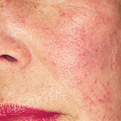Rosacea
General Information
Rosacea is a common skin disorder causing facial flushing, papules and pimples and visible blood vessels. Rosacea mostly affects fair-skinned adults between the ages of 30 – 60 and is more common in females, although males may show signs that are more apparent. Surveys show that women are more likely to get redness on the cheek and forehead, while men are more likely to have redness and swelling of the nose. The cause of rosacea is unknown, but common triggers activate the disorder. The top 10 triggers include sun exposure, emotional stress, hot weather, wind, heavy exercise, alcohol consumption, hot baths, cold weather, spicy foods and humidity. Although rosacea cannot be cured, treatments can relieve signs and symptoms. Treatment options include oral antibiotics (e.g. tetracycline) and topical antibiotics (e.g. metronidazole). Other recommendations a healthcare providers may suggest are the use of certain sunscreens, soaps and moisturizers.
Epidemiology
About 14 million Americans are affected
Etiology
Unknown; Linked to hereditary and environmental factors
Pathogenesis
Erythema (flushing and redness) on the central face, across the cheeks, nose, or forehead
Clinical
Redness and small bumps or pustules on face, rhinophyma, small blood vessels visible on nose and cheeks, burning of eyes (ocular rosacea).
Histology
Perivascular infiltrates of lymphocytes and, sometimes, plasma cells. Well-circumscribed collections of epithelioid histiocytes, usually in peri-infundibular location; granulomas surrounded usually by lymphocytes and, sometimes, plasma cells. Impressive telangiectases in the upper half of the dermis.
Bibliography
1. “Rosacea” (Online). http://www.rosacea.org/patients/index.php (visited: April 3, 2008) 2. “Rosacea” (Online). November 2006. http://www.mayoclinic.com/health/rosacea/DS00308/DSECTION=1 (visited: April 3, 2008)
Download PDF
![]() Rosacea
Rosacea


